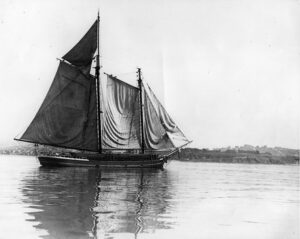
“Schooners were small vessels always sailing at the mercy of the sea, waves, and winds.” This quote comes from the notebooks of local historian Nannie Escola, found in the Kelley House Museum’s archives. Nannie loved anything to do with the sea and produced an A to Z directory of schooner names and description for those ships that visited Mendocino City.
Each ship was described by length, beam, depth of the hold, gross net weight, builder (where and when), its value, who insured it, who owned it, who captained it, and where and how it met its end. Nannie collected this information for hundreds of ships.
What did schooners carry? Railroad ties, finished lumber, cords of tanoak bark, shakes and split stuff, poles, timbers for bridge-building, merchandise for mercantile stores, and simple stuff like hay, butter, apples, sheep, and equipment for lumber mills.
The Sch. (Schooner) Iowa in 1854 came into Big River with two dozen oysters and some English Pie Fruit. The Sch. Industry left Point Arena in 1875 with a million shingles, 100 rolls of leather and one box of eggs. The Sch. John Frederick was referred to as a “butter boat,” hauling butter from Manchester to San Francisco.
Where were they going with their cargos? Anywhere in the Pacific Basin – from Mexico and South America to Australia, New Zealand, Tahiti, China, Japan, and Hawaii. Mendocino City sent lumber to Honolulu and on the return trip would bring back a cargo of bananas, rice, sugar, and molasses.
The first overseas shipment of lumber from Big River in 1855 was aboard the Dutch vessel Jan Hendrick to Sydney, Australia. The second overseas shipment was Sch. J. R. Moller loading for Valparaiso, Chile. Why ship lumber and railroad ties to these far-flung ports around the Pacific Basin? Redwood didn’t rot. It was an extremely desirable lumber for any commercial activity.
Some schooners did not start out as trade vessels. The Sch. Schida in 1889 was refitted to go from hauling lumber to walrus hunting in the north Pacific. The Sch. Bonanza was built in 1875 as a pleasure yacht for San Francisco Palace Hotel owner and banker W. Ralston. It was repurposed as a lumber schooner, then later a whaler, and was crushed by Arctic ice in 1905 near Herschel Island off the coast of northern Canada.
So many vessels wrecked that their demise may be all that is known about them. Sch. Adelaide went onto the beach at New Haven with a full load of 6,000 railroad ties that came from the Navarro Mill headed for the port of San Pedro.
If a ship that wrecked ran onto rocks or floated up on the beach and could not be re-floated and towed away for repairs, salvage crews tried to get anything useful, including cargo, masts, sails and rigging. “Wrecker” steamers were ships with cranes to facilitate salvage on the open seas.
The Sch. Galatea, built at Little River in 1875, sailed out of San Francisco and was never heard from again, nor was a trace of it ever found.
The Sch. Fannie collided with a large whale off Fish Rock northwest of Gualala in 1886. No damage was done to the ship, and “the whale has not been heard from, consequently the damage he secured is unknown.”
Whales also caused trouble for the Sch. Lizzie Derby. A whale drifted into the Navarro River harbor, much to the consternation of the captain, who worried the leviathan would get in among the ship’s mooring lines, break them, and set the ship adrift.
“The deep blue sea is in possession of information on who they were. . .” the newspaper said, reporting the disappearance of the Sch. Dashaway in 1864. The ship capsized at Big Flat, 25 miles south of Cape Mendocino. A hoop skirt and a calico dress of the wife of the captain were recognized floating in the wreckage. No one knows how many people were on board.
If readers want to know more about schooners on the Mendocino Coast and Nannie’s records of them, come visit the archives of the Kelley House Museum in Mendocino, Monday through Friday between 1:00 and 4:00. Contact us at (707) 937-5791 and curator@kelleyhousemuseum.org. Our website’s online collection also contains information and images of many ships. Go to: https://mendocinohistory.pastperfectonline.com/ and use the keyword search term “ship.”
You’ll sure to enjoy our new exhibit, “Wind & Water: The Nautical Collection of Norman de Vall,” showing through November 11, 2019, at Kelley House Museum, 45007 Albion Street, Mendocino. Museum hours are Friday – Monday 11:00 to 3:00.